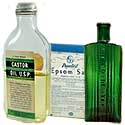Old home remedies and cures for illness

____
Extracted from the memoirs of the webmaster's mother (1906-2002) and edited by the webmaster with further research and firsthand contributions from others
When I was a child growing up in the early 1900s, chemists did a roaring trade because they gave good advice free and doctors cost money.






Some of the Victorian / Edwardian remedies and cures mentioned on this page. Photographed in various museums.
Old remedies for coughs and colds
There was a demand for Venos cough cure, Owbridges lung tonic and cherry lincture, particularly in the winter, the season of coughs and colds.
For a blocked nose
To clear a blocked up nose, Camphor oil (also known as camphorated oil) was rubbed onto our chests. Sometimes it was put onto a piece of flannel which was placed onto our chests.
For sore throats
For sore throats most people gargled with salt water. We had to be careful not to swallow it, though, as it could make people sick.
For coughs
The cough sweets were rectangular linseed lozenges with their name imprinted on them. There were also eucalyptus gums. Both were rather hot but very pleasant.
Old remedies for cuts and bruises
Iodine was widely used as an antiseptic. When my father put this on our cuts and bruises, he would say, "Shout", because he knew it would sting, and shouting would release the tension. Iodine came in a small ridged bottle to indicate that it was poison and there was a dropper in the top.
Old remedies for chapped hands and faces
For chapped hands, glycerine, cold cream or Vaseline were used. Children would often have scurf on their chins during winter, which I think was probably because we always washed ourselves in cold water and, as there was no toilet soap, we used household soap like Sunlight.
Old remedies for chilblains
For chilblains, there was Melrose, a cream with a very strong smell. Chilblains were very common in winter because there was no central heating.
Old-style laxatives
When my parents wanted a laxative, they would take a dose of Glauber salts, Epsom salts or Beecham Pills.
contributed by Len Clarke from personal experience
General purpose pick-me-ups/tonics
It was fairly common practice just to go to a chemist saying that we were under the weather and needed a 'tonic'. Of course the reason could have been anything, but we were invariably given what turned out to be just a laxative. Years later it was accepted that there was no such thing as a 'tonic'.
In the Spring all the family would have sulphur tablets which was said to be good for our blood. It was certainly a laxative as well, and the smells that it caused were most offensive.
We children would be given a dose of castor oil or syrup of figs once a week for our tummies. These too were laxatives and we were given them whether we needed them or not. For some reason, my mother always gave us the castor oil on Saturday bath night. Then on would go our clean night clothes. To see the castor oil slowly making its way down the bottle would make my tummy revolt, and my mother would give me a fixed look as much as to say, "Don't be sick". I have thought since, how stupid it was to put clean clothes on before the dose of castor oil.
| sources | webmaster | contact |
Text and images are copyright
If you can add anything to this page or provide a photo, please contact me.



